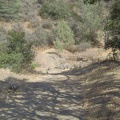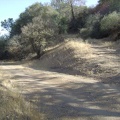16/20
Home / Mojave Preserve and Desert bikepacking trips / 2007: Henry Coe State Park Mountain-Bike Camping / Day 3: A short day hike from Mississippi Lake to Bear Spring /
A small California buckeye tree along Bear Spring Road (aesculus californica).
There's a bit of shade here, so it's a good place to take a short break from the hot sun and put down the 22-pound bag of water for a few minutes.
During the hot, dry summer, this tree goes dormant and dries up, waiting for fall rains. Its structure is revealed once all the dry leaves fall off. Many golf-ball sized seed pods hang off the leafless tree during the late fall.
California buckeye is one of those local trees that many people don't like because it loses its leaves, despite its other interesting features.
The tree photographed here is dense and squat, but many buckeyes in Henry Coe State Park have grown to be quite huge.

